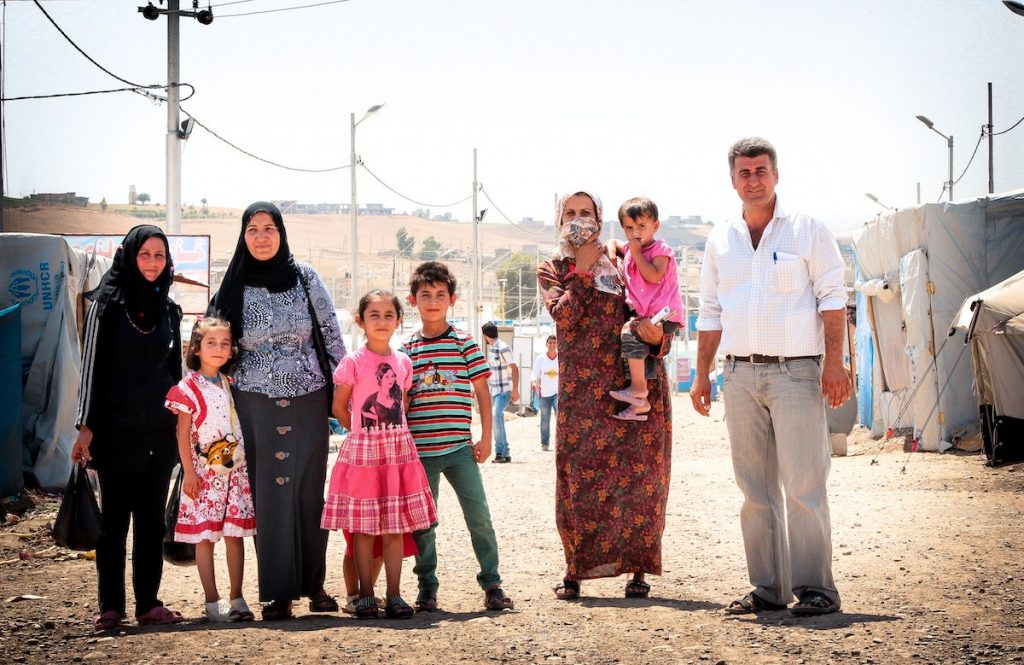
Since 2011, the war in Syria has displaced almost 6 million people; making it one of the ‘greatest contemporary refugee crises’ (Cuijpers et al, 2022). Roughly 1.5 million Syrians have become refugees in Lebanon (UNCHR, 2021). Refugees and asylum seekers fled their homes due to war, violence, and persecution; often afraid of danger to their lives and personal safety.
Post-migration experiences have been documented in research, with refugees settling worldwide meeting new challenges in their home countries (Gleeson et al., 2020; Rowley et al., 2020), including communication and language barriers, social isolation, discrimination, loneliness, stable housing, difficulties with the asylum process and mental health problems (Acarturk et al., 2021; Georgiadou et al., 2018; Ben Farhat et al., 2018). Around 22% of displaced Syrians in Lebanon have moderate to severe depressive symptoms (Naal et al., 2021). In low- and middle-income countries 0.4% of people with depression get valid treatment, and less than 0.1% of displaced people seek mental health care (Thornicroft et al., 2017).
Research in US primary care shows that, with clinician support, computerised cognitive behavioural therapy (cCBT) may be effective, but digital exclusion is an important issue that we need to consider (Brown, 2022 on Wright et al., 2021).
Researchers in Europe and Lebanon conducted a randomised controlled trial to evaluate the effectiveness of a digital intervention for depression among Syrian refugees settled in Lebanon. The study was funded by Research for Health in Humanitarian Crises (R2HC), the research programme run by Elrha. Cuijpers and colleagues (2022) aimed to understand whether guided digital CBT would work among displaced people in low- and middle-income countries.

Is the WHO-guided ‘Step-by-Step’ e-approach effective for displaced people in low- and middle-income countries?
Methods
Step-by-Step intervention
The “Step-by-Step” is a WHO-digital mental health intervention for depression. It combines psychoeducation with training in behavioural activation, stress management, gratitude, positive self-talk, strengthening social support, and relapse prevention. Each of the five sessions contains three smaller parts, around 20 minutes of visual and audio content each. Users should complete one session a week, over five weeks — once someone completes one session, the next one unlocks after four days.
Non-specialist helpers with psychology or health background can guide the users. They receive brief training focused on technical and emotional support; detecting the risk of suicide, child abuse, or gender-based violence, and referring; and supporting users through acute distress. Following a competency test, the e-helpers receive supervision from a clinical psychologist.
Design
The trial compared Step-by-Step to “enhanced care as usual” (Cuijpers et al, 2022). This control condition was ‘psychoeducation information’ plus referral to non-specialist primary healthcare. They enrolled 569 adult Syrians displaced to Lebanon with moderate or severe depressive symptoms with functional impairment. Participants had to speak Arabic or English and have a device that could access the internet.
The primary outcome measures were depressive symptoms and functional impairment. The authors used the PHQ-9, and the WHO Disability Assessment Schedule-12 (WHODAS), which covers six areas (cognition, mobility, self-care, getting along, life activities, and participation) at baseline, eight weeks later, and three months after treatment. In addition to this, the authors also looked at subjective ratings of well-being (WHO-5 Wellbeing Index), anxiety (GAD-7), post-traumatic stress (PCL-5), as well as personal problems (PSYCHLOPS), and satisfaction with the service (CSQ-3).
The authors compared the number of participants in each group who “responded” (PHQ-9 less than 50% of baseline) and “completely remitted” (PHQ-9<5 points). An intention-to-treat analysis was conducted, where participants are treated as if they completed the study in the arm they were initially randomised to.
Results
Of 1,380 volunteers, 760 were eligible participants and 569 completed the baseline assessment. After randomising, 283 refugees received Step-by-Step and 286 received ‘enhanced care as usual’.
The two groups had no significant differences in their sociodemographic characteristics. Overall, 58.7% were unemployed, and 32.0% had only primary-level education. 58.3% were female and 70.1% were married. There were no differences at baseline in PHQ-9 or WHODAS scores.
The authors found significant treatment effects for both depression and functional impairment. At the three-month follow-up, the difference remained for both primary outcomes. On the secondary outcomes, the Step-by-Step group did better than the controls, with moderate effect sizes which persisted to a three-month follow-up.
Step-by-Step was effective at halving PHQ-9 scores (“response”) and getting them below 5 (“remission”). The analysis showed numbers needed to treat of 4 for response and 6 for remission. These NNT results were the same if using the intention-to-treat analysis and if only counting those who completed the study.
203 participants (71.7%) completed the introduction session, and 91 (32.2%) reached the end of the programme. By three months, 153 participants had dropped out of the study assessments in the Step-by-Step arm (54%), and 110 from the control group (38%).

The study suggests that a guided, digital intervention may be effective at reducing depression in displaced people in Lebanon, but drop-out was a major problem in the research.
Conclusions
The researchers concluded that Step-by-Step had made a meaningful difference in the participants’ depression, function, anxiety, wellbeing, and post-traumatic stress:
The guided WHO Step-by-Step intervention we examined should be made available to communities of displaced people that have digital access.

The researchers concluded that the Step-by-Step digital intervention seemed helpful for depression, function, anxiety, well-being, and post-traumatic stress among Syrian refugees settled in Lebanon.
Strengths and limitations
The authors built further the evidence base on e-health interventions and how the Step-by-Step approach can be used with marginalised communities, especially refugee populations who often experienced high levels of distress in the host countries. The need for tailored and accessible interventions is documented across Europe and low-/middle-income settings accepting refugees; this study offers evidence to support the implementation of such digital interventions. However, the study leaves me wondering in what capacity and when these interventions can be available. Knowing that many refugees are currently forced to experience dehumanising living arrangements in unstable housing accommodation (if they’re lucky), camps, or detention centres, and without their basic needs covered – how would a digital intervention be appealing?
Although the authors intended to design and conduct a methodologically rigorous study, the high level of participants who dropped out and the evaluation of short-term outcomes for depression leaves me with more questions than answers. If we consider this an effective approach to reducing depressive symptoms, what were the reasons participants discontinued? Many assumptions can be made (i.e., cultural sensitivity, mental health difficulties, ongoing practical difficulties), but I would appreciate a statement of exploration or the author’s hypotheses around the large number of dropouts. Similarly, it would be interesting to learn more about the rationale to test the effects of the approach at 8-weeks and 3-month timepoints, and no longer periods (i.e., 6- or 12-months). As a clinician myself, I would love to see further research on the long-term outcomes of digital interventions, and the identification of novel ways to support refugees and asylum seekers.
The WHO planned to release Step-by-Step as an open-access intervention, and as such the treatment protocol of the treatment is available here. The first author highlights the importance of all investigators publishing their treatment protocols, despite their rarity. We elves agree!

Caution is needed in the interpretation of the findings due to the large number of participants who dropped out, and the potential barrier that digital exclusion may pose.
Implications for practice
Considering the effects of the intervention for refugees who remained in the study across the time points, it may mean that they felt it was user-friendly and user-appropriate. Users could choose a narrative that matched their gender, their marital status, and the appearance of the character to their ethnic group. This may be a simple way to feel related to the character in the sessions and could be applied across digital interventions or awareness material to increase access to psychological support in marginalised populations.
This study supports that Step-by-Step is effective with “e-helpers” who although they receive training, are not mental health clinicians. Weekly group supervision with a clinical psychologist balances the need for clinical oversight with scalability. This approach means that people from the most affected communities can act as helpers, encouraging others to engage with the programme. It also highlights the leadership component in the role of clinical psychologists, who can guide and provide a space for others to reflect on their skills, identity, and clinical work.

Digital interventions can be helpful for displaced populations with access to the internet and electronic devices.
Acknowledgments
DK would like to thank Dr Alistair Cannon (Maudsley Hospital) for his contribution to the initial development of this blog.
Statement of interests
DK is a trainee clinical psychologist and is interested in migration outcomes and forced displacement. Her research is focusing on the impact of family separation among refugee men.
Links
Primary paper
Cuijpers P, Heim E, Abi Ramia J, Burchert S, Carswell K, Cornelisz I, et al. (2022) Effects of a WHO-guided digital health intervention for depression in Syrian refugees in Lebanon: A randomized controlled trial. PLoS Med 19(6): e1004025.
Other references
Christina Gleeson, Rachel Frost, Larissa Sherwood, Mark Shevlin, Philip Hyland, Rory Halpin, Jamie Murphy & Derrick Silove (2020) Post-migration factors and mental health outcomes in asylum-seeking and refugee populations: a systematic review, European Journal of Psychotraumatology, 11:1, 1793567, DOI: 10.1080/20008198.2020.1793567
Lauren Rowley, Nicola Morant & Cornelius Katona (2020) Refugees Who Have Experienced Extreme Cruelty: A Qualitative Study of Mental Health and Wellbeing after Being Granted Leave to Remain in the UK, Journal of Immigrant & Refugee Studies, 18:4, 357-374, DOI:10.1080/15562948.2019.1677974
Acarturk C, McGrath M, Roberts B, Ilkkursun Z, Cuijpers P, Sijbrandij M, et al. Prevalence and predictors of common mental disorders among Syrian refugees in Istanbul, Turkey: A cross-sectional study. Soc Psychiatry Psychiatr Epidemiol. 2021;56:475–84. pmid:32789561
Georgiadou E, Zbidat A, Schmitt GM, Erim Y. Prevalence of mental distress among Syrian refugees with residence permission in Germany: a registry-based study. Front Psych. 2018;9:393.
Ben Farhat J, Blanchet K, Juul Bjertrup P, Veizis A, Perrin C, Coulborn RM, et al. Syrian refugees in Greece: experience with violence, mental health status, and access to information during the journey and while in Greece. BMC Med. 2018;16:40. pmid:29530041
Photo credits
- Photo by Jonathan Ramalho on Unsplash
- Photo by Timothy Muza on Unsplash
- Photo by Piotr Chrobot on Unsplash
